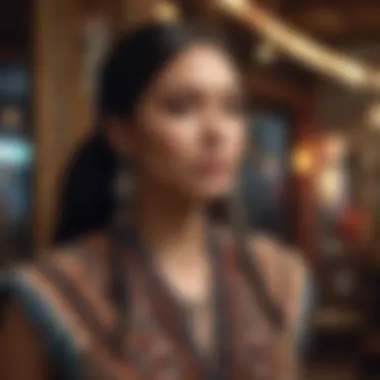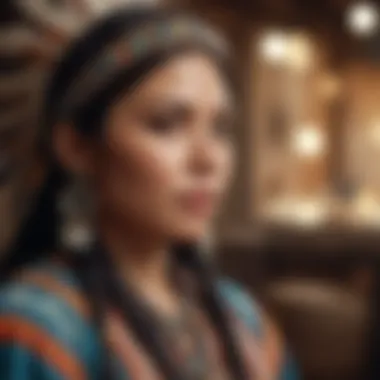Exploring the Influence of Native American Clothing Companies


Intro
The exploration of Native American clothing companies offers a unique perspective on cultural identity, economics, and creativity. These businesses are not merely about fashion; they represent a vivid tapestry of traditions, stories, and a quest for authenticity. A focus on Indigenous-owned clothing ventures sheds light on significant themes of sustainability and ethical production. Such entities contribute to a deeper appreciation of Native American heritage while also addressing contemporary economic challenges faced by tribal communities.
As we delve into this topic, we will examine various aspects: the historical context of Native American attire, the evolution of clothing brands, and their role in the modern marketplace. Additionally, we will explore highlighted companies, understand their unique designs, and consider their impact on cultural preservation. With a look into market trends and consumer preferences, we aim to capture the essence of this thriving sector in fashion as we cling back across history to seek connections to modern practices.
In our detailed discussion, we will also touch on relevant research and articles that provide an overview of this nuanced topic. Connecting the dots between heritage and fashion offers valuable insights.
Native American Clothing History
The story of Native American clothing is rich and varied, going beyond mere aesthetics. Historically, the attire served practical, ceremonial, and symbolic purposes. Each tribe had distinctive styles reflecting its environment, resources, and traditions. As such, clothing items were often made from natural materials like animal skins, plant fibers, and beads. This craftsmanship created a unique expression of identity and spirituality.
With the passage of time and shifts in societal norms, there was a gradual transition from traditional attire to modern influences, sometimes overshadowing the default knowledge of identity, art and rebellion attached to every piece woven into clothing.
As decades progressed, Indigenous artists and designers began to reclaim traditional styles and reintegrate them into contemporary contexts, creating a vibrant market zone influenced by both tourism and respect for heritage. In many cases, this means finding balance – honoring tradition while adapting to new marketplace realities.
Contemporary Native American Clothing Companies
Today, the landscape hosts a myriad of Native American clothing companies. These brands and artisans play an essential role in both fashion and cultural heritage. They create products that are not just clothing but also tell stories of peoples’ lives, beliefs, and histories. Keeping the authenticity at the forefront, many companies emphasize the quality of craftsmanship, utilizing sustainable practices and locally-sourced materials.
While exploring these companies, its also critical to acknowledge prominent figures in the industry, who have broadened their influence beyond fashion. They represent a complex array of styles: luxurious pieces adorned with intricate beadwork, contemporary garments that blend urban aesthetics with traditional designs, or handcrafted accessories made from ethically sourced materials.
Many viewers become fascinated not merely by the items themselves but by the narratives spun from the offering associated with wear that visibly connects fashion choice to culture appreciation. This link renders purchases far more significant for consumers seeking authenticity in their selections.
The analogy of fashion industry and cultural outlay weaves intricate patterns, much like the textiles themselves. In both mediums, threads signify stories passed down, shaped by numerous hands.
In the forthcoming sections, we will dissect additional themes regarding Native American clothing businesses. We'll observe market trends that emerge alongside societal shifts, illustrating how Indigenous fashion relates to broader dialogues on sustainability and justice in commerce. Furthermore, by enhancing the reader's knowledge of specific brands, the objective is to seed a deeper understanding of their implications on Native American cultural representation in global trends.
Adding to the depth of our discussion, further reference materials will list suggestions along our shared journey through lived experiences and entrepreneurship in the clothing field. Heritages reshaped are not only for spectacle but manifest as powerful symbols of pride and identity across economic dimensions.
Historical Context of Native American Clothing
The examination of historical practices related to Native American clothing gives deep understanding of their cultures. Specific elements within their garments often hold meaning that transcends mere aesthetics. As we explore the evolution of Native American attire, we see how societal changes, historical events, and contact with other cultures shaped clothing practices across numerous tribes. The traditions of fabric, colors, and styles connect to cultural identity, signaling alliances and individual tribal affiliation.
This historical understanding is imperative, as it frames present-day expressions in Native American clothing businesses. By acknowledging traditional practices, we can appreciate the roots of contemporary attire better. It’s a journey of evolution, femininity, masculinity, spirituality, and functionality combined round these groups who possess unique worldviews. In this section, we will delve into two specific areas: traditional clothing practices and the symbolism interwoven in Native American attire.
Traditional Clothing Practices
Traditional clothing reflects the environments Native American tribes inhabit. Various materials, such as animal hides and plant fibers, were common in attire. Native communities crafted garments well-suited for climate and activities unique to their regions. The type of materials and methods varied between groups, shaped by access to resources.
For example, Plains tribes used the buffalo extensively, creating utilitarian outfits. The Arctic cultures utilized animal skins which then were tailored into clothing that maintained warmth in frigid temperatures. Lesser-known practices include the weaving of intricate baskets and textiles among the tribes of the Southwest.
Manufacturing methods also differed across tribes. Some preferred decorated styles with colorful beads, while others favored minimalism. Traders and other outside influences later brought new materials, which led to design evolution. Nonetheless, they maintained significant links to their past practices while integrating fresh concepts into their fashion. The traditional practices serve as an essential narrative of identity, functioning as lifelines for clans across generations.
Symbolism and Spirituality in Attire
Every detail in traditional Native American clothing has profound symbolism. Colors, patterns, and specific items convey spiritual and cultural narratives. Some patterns symbolize harmony, balance, and connection to nature. Additionally, distinct colors may represent tribal affiliation or specific ceremonial significance.
These garments are not just for adornment; they carry blessings and protective meanings. For instance, cuirass no only signals status in a community but are rooted in spiritual symbolism, uniting the wearer with heritage and ancestors. Unique accessories like feathered headdresses or shell jewelry also enhance individual identity, often signifying achievements and social standing.
Cultural Significance of Clothing
Clothing extends beyond mere fabric; it serves as an essential medium for cultural expression. Within the Native American context, the cultural significance of clothing is profound, as it embodies identity, tradition, and artistry. Clothing reflects the history and values of tribes, representing their unique narratives and experiences. The exquisiteness of textiles and designs encapsulates both functionality and a deep connection to the past, making it an indispensable aspect of cultural preservation.
Identity and Representation
The influence of clothing in shaping identity cannot be overstated. For many Native Americans, their garments symbolize heritage and cultural pride. Identity is intricately linked with clothing choices, as they provide a way to celebrate lineage and belonging. Wearing traditional attire during significant events like powwows and ceremonies reinforces community ties and promotes visibility of their cultural roots.


Beyond belonging, clothing also fosters representation in wider society. Unique patterns, beads, and symbols are not just aesthetic choices; they narrate the history and stories of the peoples. Native American clothing can thus communicate cultural identity in spaces where verbal articulation may be challenging—in visual forms. It drives a sense of empowerment because, through their apparel, Native Americans assert their existence against a backdrop of historic invisibility.
Clothing as a Cultural Narrative
Every piece of Native American attire serves as a narrative vessel. The designs represent stories interwoven with historical events, spiritual beliefs, and community values. Patterns can signify tribal connections while colors may correlate with natural elements, showcasing a respect for the environment.
Fabric itself carries traditions. Techniques in weaving, quilting, or beadwork can link to teaching efforts passed down through generations. In Native American culture, these methods appear deeply embedded in life, signifying more than just craft skills; they preserve the cultural legacies of their ancestors. It highlights the seamless continuity between the past and present—enriching the fabric of their identity.
Overview of Native American Clothing Companies
Native American clothing companies serve a unique and vital role in the cultural landscape of the communities they represent. They bridge the gap between tradition and modernity, allowing for the art of clothing design to serve as a medium of cultural expression and economic opportunity. This section examines the emergence and growth of these businesses and explores the factors driving market demand in a global fashion landscape increasingly seeking authenticity and cultural significance.
Emergence and Growth of Businesses
The emergence of Native American clothing companies reflects a growing desire among Indigenous peoples to reclaim and promote their cultural heritage through fashion. Over the past few decades, there has been a noticeable upswing in businesses developed by Native entrepreneurs who focus on creating skilled craftsmanship and applying traditional techniques. Many of these companies provide not only clothing but also accessories that carry profound cultural meaning and narrative.
Several pivotal moments contributed to this growth. In the 1970s, the American Indian Movement and the push for Indigenous rights ignited interest in Native culture, further awakening a public enthusiasm for authentic Indigenous art and fashion. More recently, increasing interest in ethical and sustainable fashion choices coincided with the revival of traditional Native clothing practices. These movements have fostered an environment where Native brands can flourish, elevating their narrative both creatively and commercially.
“As a way of expressing culture, clothing becomes a powerful medium that carries stories and ancestral knowledge.”
The continued success of these businesses highlights the ability to leverage cultural practices as sustainable economic ventures. Companies like Lise's Cahokia, which specializes in accessories inspired by traditional artistry, have experienced exponential growth due to their unique products that honor cultural heritage. Brand awareness is continuously growing among populations who admire ethical sourcing and craftsmanship.
Factors Driving Market Demand
Market demand for Native American clothing is influenced by several intersecting factors. One primary driver is consumer appetite for authenticity. As larger fashion brands struggle with cultural appropriation issues, shoppers increasingly seek genuine Native craftsmanship that tells genuine stories.
Moreover, the fetishization of exotic cultures in mainstream fashion compels consumers to look for responsible brands with transparency in sourcing. Native American clothing companies deliver this sense of authenticity. Many customers prioritize ethical fashion that resonates with their identities and ethical stance. This trend propels sales, establishing a central position for Native brands in active consumer markets.
Additionally, significant spikes in interest on social media platforms amplify the visibility of Native American culture. With e-commerce and social media, small businesses gain unprecedented opportunities to reach global audiences, fostering deeper engagement and boosting sales.
In sum, Native American clothing companies not only contribute to the preservation of traditional practices but also respond to the consumers’ quest for meaningful cultural connections. They assert themselves within the modern market landscape while providing resources for local communities. Recognizing their impact is essential for understanding the contemporary narrative of Native American fashion.
Case Studies of Prominent Companies
The examination of specific Native American clothing companies offers several insights into their roles in the cultural and economic landscape. By studying these businesses, we gather understanding on how clothing not only preserves history but also fosters sustainability and concerns around appropriation. The importance arises from demonstrating real-world cases where traditional practices align with contemporary needs.
Company Profiles
1.
Svosy Wíičh'ake
Founded by Native American Designer Ahna Gchante Kodya, Svosy Wíičh'ake has its roots in values of authenticity. The designs reflect traditional motifs while integrating urban wear elements. This blend meets the demand of a younger audience looking for representation and genuine connections to their heritage.
Their collections include handcrafted dresses, jackets, and accessories that resonate with the story of their tribes.
2.
Tehama Textile Company
Tehama Textile Company stands out for its women's apparel line that centers on sustainable fibers. They prioritize sourcing organic materials locally. Each product tells a narrative that parallels the ecological ethos important within Native American communities. Employing local artisans protects knowledge and technique about textile creation that might otherwise face extinction.
This company showcases how honoring practices from the past can provide meaningful employment today.
3.
NativeTrendz Interestingly, NativeTrendz navigates modern e-commerce platforms expertly. Founded by several indigenous artists, this online space consists of a broad selection of jewelry, clothing, and art. The collaboration allows for cross-pollination of various tribal designs, creating a fair-trade marketplace. Increasing their customer reach opens pathways for younger generations who yearn for connection to their culture through direct economic support.
Product Lines and Innovations
Native American clothing companies exemplify innovation while embracing tradition. The diverse product lines crafted by companies range heavily, yet they all leverage traditional practices.
- Cultural Clothing: Items featuring authentic tribal designs or colors that share small insights on each tribe’s background can be seen frequently.
- Contemporary Apparel: Popular among younger audiences, there are modern cuts and designs integrated with Native American art reflecting contemporary lifestyle positively.
- Accessories: Often innovative, accessories include uniquely crafted jewelry, handbags, and shawls exploring combinations of materials representing spirituality.
The influence of technology facilitates smart branding. Social media strategies are classic elements in showcasing collections alongside their stories.
Real-time data through e-commerce sales unlocks substantial market insights, facilitating research into consumer preferences and guiding future designs.
The amalgamation of tradition and modernity lies at the heart of Native American clothing companies, highlighting cultural narratives while addressing modern market dynamics.


Through studying specific companies, we underscore the blend of heritage with the impact they hold in local economies, community bonding, and preserving a vibrance of cultures within these clothing practices.
Impact on Local Economies
The role of Indigenous clothing companies extends beyond cultural expression; it significantly impacts local economies. This impact stems from job creation, skill development, and the economic foundation these businesses provide within Indigenous communities. Sustainable business practices in this sector can not only preserve culture but also promote financial independence.
Job Creation and Skill Development
Native American clothing companies contribute to job creation in various ways. They generate employment opportunities specifically tailored to members of their communities. This helps create awareness of traditional skills in weaving, beadwork, sewing, and dyeing, among other crafts.
Moreover, these companies often offer training programs that enhance today's skill set. Participating in such programs enables individuals to gain legitimate work experience, an essential factor in both personal and professional growth. The emphasis on traditional crafts fosters a renewed interest in reviving nearly-lost arts, channeling them into sustainable income avenues.
In addition to traditional artistry, jobs may also open in fields such as marketing, finance, and production logistics, pushing for overall community development. In many cases, local educational institutions collaborate with businesses to tailor specific training.
Key Highlights
- Revitalization of traditional crafting dies: provide vital source of income.
- Diverse career paths: open channels into modern marketing and commerce.
- Skills transfer: community educators lead workshops, mentored by more experienced artists.
Support for Indigenous Communities
The existing clothing companies also extend their stature to support broader community initiatives. By focusing on creating apparel steeped in cultural relevance, their economic viability often finds its roots deeply embedded in community backing. Through these companies, profits can play a role in broader support systems.
Often, these entities are aligned with local charities, cultural events, and youth programs, utilizing proceeds to improve educational opportunities, support health programs, and fund artistic endeavors. Partnerships with schools and cultural centers help forge stronger local ties.
As responsible businesses, they recognize the holistic interplay of commerce and communal welfare. Awareness is here significant; each purchase of cultural paraphernalia is a contribution towards ensuring future generations carry these traditions forward.
Ultimately, this emblematic relationship strengthens identity, shoeing cultural significance through responsible and community-oriented intentions.
Challenges Facing Native American Clothing Companies
The landscape of Native American clothing companies is a complex one. While these businesses contribute to the cultural identity and economic strength of Indigenous communities, they also face significant challenges. Understanding these challenges is essential to appreciate the dynamics within the garment sector occupied by Native Americans, as they reflect broader social issues and trends. From cultural appropriation debates to market competition, these obstacles shape the future of Native American fashion.
Cultural Appropriation Issues
Cultural appropriation remains a pressing challenge for Native American clothing companies. This refers to the often unacknowledged or inappropriate copying of traditional designs, materials, and symbols by non-Indigenous entities. Many times, these outsiders profit from representations of Native culture without providing recognition or compensation to the communities that originated them.
This issue not only raises deep ethical and legal concerns but also adds pressure on Indigenous designers striving to maintain authenticity and protect their cultural heritage. Some businesses find themselves submerged in a contentious ocean of copyright disputes and public criticism. In this context, the importance of educating consumers about the significance of traditional motifs becomes paramount.
“Every pattern, every thread, carries a story about us—our history, our resilience. It's more than a fashion statement; it’s identity.” —An Indigenous designer
Many Native American brands emphasize their distinctiveness as a protective measure. Highlighting the origin of their designs serves to combat inappropriate appropriation and accentuates authenticity. Fostering awareness can bridge the divide between cultures, promoting respect toward the storytelling imbued in clothing traditions.
Market Competition and Sustainability
Native American clothing companies also navigate a landscape marked by fierce competition. Global fashion markets are increasingly filled with brands offering a myriad of choices. This influx can make it challenging for small businesses to gain visibility. Compounding this issue, mass-produced garments dominate the market. They often come at a lower price point, challenging Indigenous designers to articulate and reinforce their value.
Additionally, sustainability is an important topic, given the rise in consumer demand for eco-friendly practices. Many Indigenous companies naturally align with sustainable practices, as reverence for nature is a deep-rooted aspect of their culture. However, engaging in sustainability is an endeavor that often requires resources that small businesses may lack—financial backing, advanced technology, and comprehensive supply chain networks.
To address these concerns, strategic partnerships within communities and beyond may help local brands unify their efforts. Experience-sharing among designers can bolster objectivity in approaches, making them capable to face large-scale competition. This cooperation can introduce innovative practices encompassing both sustainability initiatives and effective marketing strategies. Together, the community stands to reinforce the visibility and success of Native American clothing companies.
The Role of Technology in Modernizing Traditional Practices
The intersection of technology and traditional Native American clothing practices represents a significant evolution in the fashion landscape. These advancements allow Native American clothing companies to preserve cultural heritage while embracing modernization. The use of technology is reshaping how these entities create, market, and sell their products, creating a vital connection between ancient practices and contemporary demands.
E-commerce Platforms and Outreach
The rise of e-commerce has transformed the business operations of many Native American clothing companies. Online marketplaces like Etsy and individual websites provide an openness that was not available beforehand. These platforms enable artisans to reach a global audience without the limitations of a physical storefront.


Key elements of e-commerce adoption include:
- Accessibility: More people can access unique clothing items without geographical constraints.
- Diverse product range: The ability to showcase a variety of textiles, patterns, and designs that hold cultural significance.
- Cost-effectiveness: Lower overhead costs compared to maintaining a brick-and-mortar store.
Outreach strategies through e-commerce also allow these companies to create stronger brand narratives. Many firms highlight their commitment to sustainable practices and cultural authenticity right on their homepages. This in itself piques consumer interest and enhances trust in their products. Unique stories about how traditional techniques are infused into modern styles contribute to the richness of the brands developed.
Social Media as a Marketing Tool
Social media platforms such as Instagram, Facebook, and TikTok have become essential for fostering brand recognition and community among Native American clothing companies. These platforms serve dual purposes - marketing and storytelling. Through engaging content, brands dissect the inspiration behind their attire, grounding every collection in cultural narratives.
The main advantages of social media in this context include:
- Direct engagement: It fosters a two-way conversation between brands and consumers, enabling feedback and deeper connections.
- Visual storytelling: The intricacies of design can be effectively communicated, allowing potential customers to appreciate the craftsmanship involved.
- Trend responsiveness: Brands can quickly adjust their strategies based on audience reactions or emerging trends within contemporary fashion.
Social media helps revive techniques and styles that would otherwise remain unseen. It is a bridge connecting our traditional values with the global fashion world.
There are continual considerations on how broader technology integration can impact the authenticity of Native American clothing. Successful companies navigate challenges such as cultural appropriation while leveraging modern tools. The responsibility lies in maintaining cultural integrity while introducing their artistry to wider audiences. Fundamentally, technology is about balancing progress and tradition in showcasing Native American fashion in the right light.
Sustainability Practices in Native American Fashion
The concept of sustainability holds particular significance for Native American clothing companies. These companies not only produce fashion items but furthermore serve as vital connectors to their heritage and beliefs. Embracing sustainability practices ensures they honor their crisp links to land, community, and tradition. As an emerging trend in various industries, the relevance of sustainability in fashion has grown significantly. This delicate balance of respecting cultural history while meeting modern market demands is something prominent in the practices of Native American clothing companies.
Material Sourcing and Ethical Production
One fundamental aspect of sustainability in this context is the choice of materials. Native American companies usually prioritize using natural, locally sourced materials. Fabrics such as cotton, wool, and leather are commonplace. They often honor traditional methods, implementing sustainable harvesting practices that minimize environmental disruption.
Furthermore, ethical production stands out as a core component. It involves paying fair wages to local artisans and ensuring the involvement of Indigenous peoples in the entire production process. This creates a direct link between commerce and community, enriching both the creator and consumer. Creating transparency about where materials come from builds trust and appreciation in the marketplace.
- Natural Resources: Utilization of natural fibers often limits ecological harm.
- Community Engagement: Supporting local artisans gives significant cultural value.
- Authentic Practices: Maintaining traditional craftsmanship links products back to identity.
Environmental Responsibility
Native American clothing companies are taking strides to incorporate environmentally friendly practices into their businesses. Environmental responsibility includes adopting methods that minimize waste and reduce carbon footprints. This is crucial for preserving the ecosystems cherished by Indigenous cultures.
One example of such actions could include the use of solar energy in production facilities. Companies may also practice recycling and upcycling materials to mitigate waste.
Some brands raise awareness around sustainable practices through educational campaigns. Their outreach can enlighten consumers about the environmental impact of clothing, helping to shift paradigms in the marketplace. By aligning marketing strategies with environmental accountability, they can manifest significant impacts both locally as well as globally.
- Waste Reduction: Adopting sustainable supply chains lessens landfill contributions.
- Renewable Energy: Integration of clean energy solutions fosters eco-conscious practices.
- Educative Initiatives: Raising consumer awareness contributes to lasting change.
Staying true to their cultural ideologies, these companies symbolize the blend of tradition and modernity. Their commitment to sustainability reflects deeper respect for Mother Earth and their own heritage.
In the climate of fast fashion, the efforts of Native American clothing companies to implement sustainability practices yield vital lessons. This intersection, emphasizing cultural integrity while prioritizing ecological health broaden discussions about meaningfully responsible consumption.
Future Trends in Native American Clothing Companies
The landscape of Native American clothing companies is developing continually. As cultural narratives shift and society increasingly values authenticity and sustainability, these businesses stand at the confluence of tradition and innovation. Understanding these future trends helps to highlight their relevance in the broader context of fashion and cultural preservation. There are several important themes emerging in this trail blazing area of the fashion industry.
Evolving Cultural Narratives
Evolving cultural narratives play a vital role in the current and future direction of Native American clothing companies. As younger generations of Native Americans increasingly seek to reclaim and express their heritage, clothing becomes a useful mediudm for connecting with cultural identity. This reclaiming is on different levels, including styles, patterns, and techniques. The re-establishment of traditional motifs repurposed into modern designs not only preserves history but also draws interest from non-Native audiences.
Furthermore, storytelling is becoming an essential part of branding. Companies often narrate the history and significance of their designs, insisting on the importance of authentic representation rather than purely aesthetic appeal.
- "Fashion is more than clothing; it is storytelling, identity and a reverent partnership with our past."
Global Market Trends
The global market is shifting towards more inclusive and diversified fashion principles. Native American clothing companies may more assertively pursue this trend. Recent consumer behaviors underline a rising demand for ethical and sustainable products. Shoppers are concerned about supply chains and the welfare of the communities that produce their clothing. This encourages Native American brands to prepare for an international market focused on quality and sustainable values.
Additionally, the inclusion of technology in marketing and sales opens new doors for expansion. Strategies such as utilizing social media platforms and e-commerce websites enable unique cultural expressions to reach wider audiences. Adjusting to these shifting market dynamics is crucial for sustainability, allowing these brands to thrive and impact beyond local economies.
In summary, following these particular trends not only augments the unique qualities of Native American cultural expression but also places these clothing companies on a global stage, fostering awareness and authentic collaborations throughout the fashion industry.







